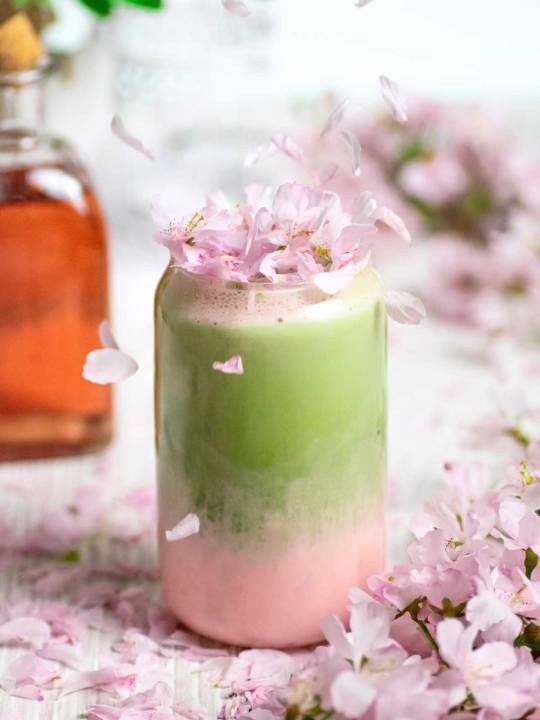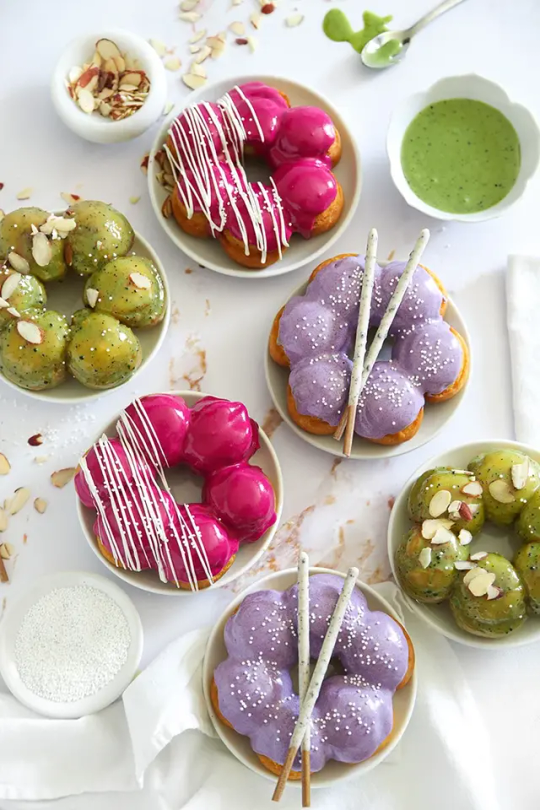#Japanese matcha
Explore tagged Tumblr posts
Text

Matcha Ice Cream
Hot and humid again☀️. Best to enjoy a simple matcha ice cream on cone🍦. Not too sweet. Very refreshing to cool of the humidity🍃. Simple and cool. From ��Soft Swerve”.
#food blogger#foodie#blogoftheday#cuisine#food photography#foodgasm#foodporn#asian food#food diary#delicious#japanese matcha#matcha ice cream#ice cream#cool#refreshing#pastry#refreshment#summer snack#sweet snack#japanese snacks#vegan snacks#matcha#food blog#food photo blog#blogger#simple food#sweet dessert#asian dessert#japanese dessert#tasty food
9 notes
·
View notes
Text


Wondering what it feels like to drink Matcha on a Spring day 🍵🌸
#digital art#aesthetic#springtime#matcha#cute art#kawaii#japanese matcha#artists on tumblr#other art
5 notes
·
View notes
Text
Is Matcha Japanese or Chinese? Unveiling True Origins
In this post, you’ll discover whether matcha originates from Japan or China. In my shop, you will find original, top-quality Japanese teas, directly from Japan. These are true gems among teas that will provide you with an authentic taste experience straight from the Land of the Rising Sun. Matcha is a vibrant green tea powder that has gained immense popularity worldwide for its unique flavor,…
#best matcha for beginners#ceremonial grade matcha#Chinese matcha#Chinese tea culture#green tea vs. matcha#Japanese matcha#Japanese tea culture#matcha benefits#matcha history#matcha origins#matcha powder differences#matcha production methods#matcha vs. green tea
2 notes
·
View notes
Text
instagram
#love#matcha#ice cream#pina colada#affogato#japanese matcha#recipes#handmade ceramics#home cafe#cozymood#breakfast#summer#foodie#yummy#food blog#tropical#Instagram
4 notes
·
View notes
Text
1 note
·
View note
Text
Exploring the World of Chinese Red Tea and the Best Japanese Matcha: A Journey Through Tradition and Flavor
Tea culture is a rich tapestry woven from centuries of tradition, artistry, and a deep appreciation for the subtle complexities of flavor. Among the myriad of teas that have captivated the palates of tea enthusiasts worldwide, Chinese red tea and Japanese matcha stand out for their unique characteristics and cultural significance. In this blog, we will delve into the rich heritage and health benefits of Chinese red tea and explore why Japanese matcha is often hailed as one of the best teas in the world. As you embark on this journey, you will discover the nuances that make these teas beloved by millions, including tea lovers in the USA.
Introduction to Chinese Red Tea
Chinese red tea, known as "hong cha" in China, is what Westerners commonly refer to as black tea. However, in China, the name "red tea" is derived from the reddish-brown color of the brewed tea, which sets it apart from what is known in the West as black tea. Chinese red tea is a fully oxidized tea, known for its robust flavor, rich color, and smooth, slightly sweet finish. It is one of the most popular teas in China and has been an integral part of Chinese culture for centuries.

The History and Tradition of Chinese Red Tea
The origins of Chinese red tea can be traced back to the Ming Dynasty (1368–1644), a period when tea production techniques were refined and standardized. During this time, the process of oxidizing tea leaves fully to create what we now know as red tea was developed. This method of tea production spread throughout China, leading to the creation of various regional varieties, each with its own distinct flavor profile.
One of the most famous types of Chinese red tea is Keemun, produced in the Qimen County of Huangshan City, Anhui Province. Keemun is known for its rich, wine-like flavor and delicate smoky notes, making it a favorite among tea connoisseurs. Another well-known variety is Yunnan red tea, or Dianhong, which is celebrated for its bold, malty flavor and hints of chocolate.
The Health Benefits of Chinese Red Tea
Chinese red tea is not only cherished for its taste but also for its numerous health benefits. Rich in antioxidants such as theaflavins and thearubigins, Chinese red tea helps reduce inflammation and combat free radicals in the body. Regular consumption of red tea has been linked to improved heart health, as it may help lower cholesterol levels and reduce the risk of stroke.
Additionally, Chinese red tea contains a moderate amount of caffeine, providing a gentle energy boost without the jitters often associated with coffee. This makes it an excellent choice for those looking for a smooth, energizing tea that also supports overall well-being.
Introduction to Japanese Matcha
Moving from the rich, earthy tones of Chinese red tea, we enter the vibrant, green world of Japanese matcha. Matcha is a finely ground powder made from specially grown and processed green tea leaves. Unlike traditional green tea, where the leaves are steeped in water and then discarded, matcha is consumed entirely, offering a more concentrated dose of nutrients and flavor.
Japanese matcha has been an integral part of Japanese culture for centuries, particularly in the traditional tea ceremony known as "chanoyu." This ceremony emphasizes mindfulness, simplicity, and respect for the process of making and enjoying tea.
Why Japanese Matcha is Considered the Best
Japanese matcha is often regarded as one of the best teas in the world due to its unique production process and health benefits. The cultivation of matcha involves shading the tea plants for several weeks before harvest, which increases the chlorophyll content and enhances the production of amino acids, particularly L-theanine. This process results in the vibrant green color and rich umami flavor that best Japanese matcha is known for.
After harvesting, the tea leaves are steamed, dried, and ground into a fine powder using traditional stone mills. The meticulous attention to detail in every step of production is what sets Japanese matcha apart and earns it the title of the best Japanese matcha.
The Health Benefits of Japanese Matcha
Japanese matcha is a powerhouse of nutrients and antioxidants, offering a wide range of health benefits. Because the entire tea leaf is consumed, matcha provides a higher concentration of antioxidants compared to regular green tea. These antioxidants, particularly catechins like EGCG (epigallocatechin gallate), help protect the body against chronic diseases, reduce inflammation, and support overall cellular health.
Another key component of Japanese matcha is L-theanine, an amino acid that promotes relaxation without causing drowsiness. This, combined with the caffeine content, provides a calm, focused energy, making matcha an excellent choice for enhancing concentration and mental clarity.
Regular consumption of Japanese matcha has also been linked to improved cardiovascular health, weight management, and detoxification. Its ability to boost metabolism and burn calories makes it a popular choice for those looking to support a healthy lifestyle.
How to Enjoy Chinese Red Tea and Japanese Matcha
Both Chinese red tea and Japanese matcha offer unique and enjoyable ways to experience tea. To brew Chinese red tea, start by using freshly boiled water and steeping the tea leaves for 3-5 minutes, depending on your preferred strength. The resulting brew should be a rich, reddish-brown color with a robust flavor. Chinese red tea can be enjoyed plain or with a splash of milk and honey to enhance its natural sweetness.
On the other hand, preparing Japanese matcha is a bit more involved, but the process is part of the experience. Begin by sifting 1-2 teaspoons of matcha powder into a bowl to remove any clumps. Add a small amount of hot water (not boiling, around 175°F or 80°C) and whisk vigorously in a zigzag motion using a bamboo whisk until the matcha is frothy. Matcha can be enjoyed on its own or mixed with milk for a creamy matcha latte.
Conclusion: Embrace the Richness of Chinese Red Tea and the Purity of Japanese Matcha with Acala Tea Company
Whether you are drawn to the bold flavors of Chinese red tea or the smooth, vibrant taste of Japanese matcha, both teas offer a journey through history, culture, and health. At Acala Tea Company, we are committed to bringing the finest teas from around the world to tea lovers in the USA. Our selection of Chinese red tea and best Japanese matcha reflects our dedication to quality and tradition.
Explore our collection today and discover the unique flavors and health benefits that these exceptional teas have to offer. Whether you are looking to start your day with a robust cup of Chinese red tea or enjoy a moment of calm with a bowl of Japanese matcha, Acala Tea Company has the perfect tea for you.
0 notes
Text

1 note
·
View note
Text
Transform Your Home into a Tea Haven: Explore Yuki's Matcha Accessories
Create your own tea sanctuary at home with our exquisite collection of matcha accessories from Yuki's Tea Shop. From traditional bamboo whisks to elegant ceramic bowls, our handcrafted accessories are designed to elevate your tea ritual and enhance your matcha experience. Whether you're practicing the art of matcha preparation or simply enjoying a quiet moment of reflection with a cup of tea, our matcha accessories add a touch of elegance and authenticity to every sip. Explore our curated collection today and elevate your tea journey with Yuki's Tea Shop.
0 notes
Text

Matcha & Strawberry Ice Cream With Matcha Powder
A hot and humid summer is the time to have an ice cream of matcha and strawberry flavour🍦. With matcha powder as toppings. Very cool with light sweetness. Natural ingredients imported from Uji, Japan. High quality and authentic flavour🍵. From Harima Garden’s Tea manufacturing. Takes long process to make a few dozen grams of matcha✨. Very precious to try this authentic ice cream. From “Matcha Cafe Maiko”
#foodie#food blogger#blogoftheday#cuisine#food photography#foodgasm#foodporn#asian food#food diary#delicious#matcha ice cream#strawberry ice cream#ice cream#summer diary#japanese matcha#japanese dessert#high quality#authentic food#authentic flavors#sweet food#sweet snack#pastry#refreshment#tasty food#very tasty#so tasty#tasty#delicious food#deliciousness#sweet dessert
4 notes
·
View notes
Text
From Nature to Cup: Discovering the Hidden Wonders of Matcha Tea Powder and Its Botanical Brilliance
In a world where countless beverages vie for our attention, one particular tea stands out for its vibrant green hue, unique flavor, and remarkable health benefits: matcha tea powder. Originating from Japan and deeply rooted in its rich cultural heritage, matcha has captivated the taste buds and piqued the curiosity of tea enthusiasts around the globe. Beyond its visual appeal and distinct taste, matcha possesses a host of hidden wonders and botanical brilliance that make it truly extraordinary.
A brief overview of matcha tea powder
Japanese matcha is not your ordinary cup of tea. Unlike traditional teas, which are steeped and discarded, matcha is a finely ground powder made from specially grown tea leaves. This means that when you consume matcha, you are actually ingesting the whole leaf, resulting in a more potent and concentrated experience. With its smooth and velvety texture, matcha offers a unique sensory journey that sets it apart from other teas.

Historical Background and cultural significance of Matcha
Matcha tea powder, with its historical background and cultural significance, has become an integral part of Japanese tradition and society. Introduced from China by Buddhist monks in the 9th century, matcha was initially reserved for meditation and later embraced by samurais for its mental clarity benefits. Today, matcha is celebrated in traditional tea ceremonies as a symbol of hospitality. The cultivation and harvesting of matcha involve meticulous shade-grown techniques, hand-picking of the finest leaves, and a precise production process. These time-honored methods preserve matcha's vibrant green color, unique flavor, and abundant health benefits, encapsulating centuries of tradition and botanical brilliance in every cup.
The Nutritional Powerhouse
Matcha is not just a delightful beverage; it is also a nutritional powerhouse that offers a myriad of health benefits. Let's explore the key health benefits of matcha and why it has gained a reputation as a superfood.
Rich in antioxidants, particularly EGCG, protecting against cellular damage and promoting overall well-being.
Abundant in essential vitamins (A, C, E) and minerals (potassium, calcium, iron) for immune function and vitality.
Provides a balanced energy boost with natural caffeine and L-theanine, enhancing focus and mental clarity.
Potential health benefits include reducing the risk of chronic diseases, aiding weight management, and promoting relaxation and stress reduction.
From Leaf to Powder: The Art of Processing
The journey of Japanese matcha begins with the careful selection and handpicking of tea leaves, ensuring only the finest ones are chosen. These leaves then undergo a series of meticulous steps in the processing factory. They are steamed to preserve their vibrant green color and unlock their unique flavors and aromas. After drying, the leaves are deveined to achieve a smooth texture. The next crucial step involves stone milling, where the leaves are ground into a fine powder. This traditional technique preserves the natural qualities of the leaves. The final product's taste and aroma are determined through a quality grading process, considering factors like color, texture, and fineness. The art of processing matcha showcases the dedication and skill of producers, transforming simple leaves into a vibrant, aromatic, and flavorful powder. Each sip of matcha reflects careful craftsmanship and attention to detail, allowing us to savor the beauty of this remarkable botanical creation.
Incorporating matcha into a healthy lifestyle
Matcha offers a delightful way to enhance a healthy lifestyle. By incorporating matcha into daily routines, such as starting the day with a warm cup of matcha or adding it to smoothies and baked goods, one can enjoy its numerous health benefits. Matcha can be a refreshing alternative to other beverages, providing hydration along with its nutritional power.
Exploring different flavor profiles and culinary experiments
Matcha's versatility extends beyond traditional and botanical tea preparation. Its distinct flavor profile can be explored in various culinary creations. From matcha-infused desserts like cakes, cookies, and ice creams to savory dishes such as matcha-infused sauces and marinades, there are endless possibilities for culinary experimentation. Embracing matcha opens up a world of unique flavors and culinary delights.
Finding reputable matcha brands and suppliers
To fully experience the wonders of matcha, it is essential to find reputable brands and suppliers. Look for matcha that is sourced from high-quality botanical tea leaves, cultivated using traditional methods, and processed with care. Reliable suppliers prioritize the freshness and authenticity of their matcha, ensuring a vibrant green color, rich flavor, and optimal nutritional content. Reading reviews and seeking recommendations can guide you in finding reputable sources of matcha.
Conclusion
Incorporating matcha into everyday life is an invitation to experience the hidden wonders of this remarkable tea powder. Beyond its vibrant color and unique taste, matcha offers a wealth of health benefits, from its antioxidant power to its natural energy boost. Embracing matcha allows us to connect with centuries of tradition, savor the beauty of its botanical brilliance, and explore its endless possibilities in the culinary realm. So, let matcha become a cherished companion on your journey to a healthier, more vibrant lifestyle.
1 note
·
View note
Text


instagram.com/p/C-sIvFjP616/?igsh=am44eXVjNXVsamh5
712 notes
·
View notes
Text

Cherry blossom matcha sakura latte
#matcha latte#matcha#cherry blossom#drinks#food#sakura#japanese food#drink#milk#matcha powder#sweet food#sweet#sweets#tasty#foodporn#delicious#cooking#food photography#foodgasm#recipe
672 notes
·
View notes
Text

Mochi Donuts (Pon de Ring-Inspired)
#mochi doughnuts#mochi#pon de ring#food#dessert#matcha#green tea#color#green#purple#pink#red#glaze#almond#nuts#poki#asian#fusion#recipe#kids#breakfast#tea time#tofu#soy#white chocolate#tea#taro#japanese#doughnuts#sprinklebakes
314 notes
·
View notes
Text









⋆🎐₊˚ ⊹‧₊˚ 🍵༉‧ ₊˚ . sanemi core ࿐࿔.⋆。˚
#sanemi#sanemi shinazugawa#shinazugawa sanemi#kny sanemi#kny#kimetsu no yaiba#demon slayer#sanemi core#moodboard#layouts#pfp#icons#aesthetic#green#japanese#japan#kkmn.txt#matcha#ohagi#messy moodboard#moodboards
379 notes
·
View notes
Text

654 notes
·
View notes
Text


2023/06/05
really struggling to stay on track with summer school, so i’m back to living by the planner
#lupusmaxima#dark academia#bookblr#chaotic academia#brown#coffee#beige#literature#studyblr#classical literature#planner#aesthetic#matcha#green#macarons#sweets#food#tea#keyboard#japanese#nihongo#日本語の学生
1K notes
·
View notes